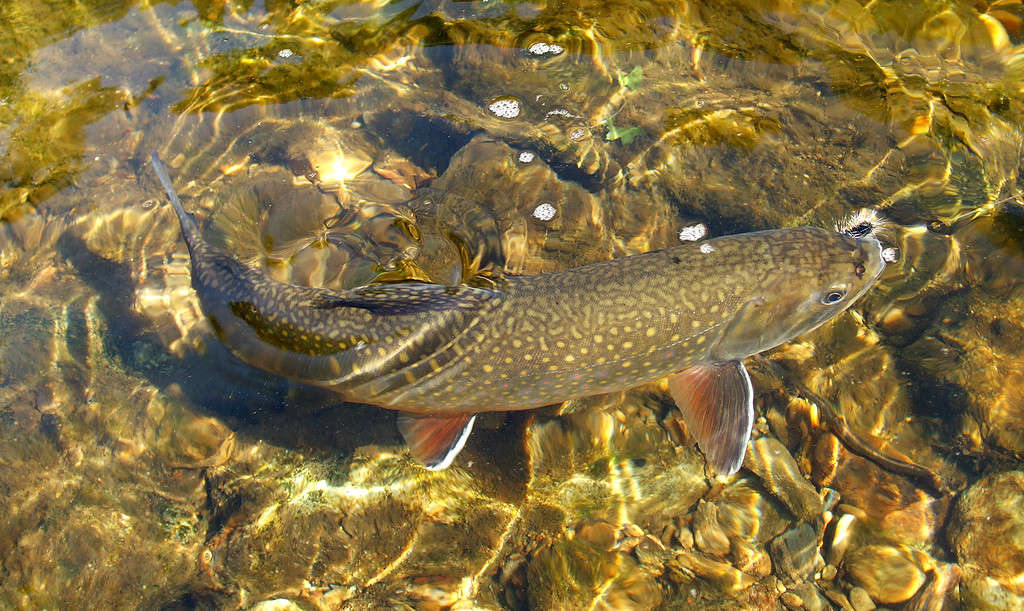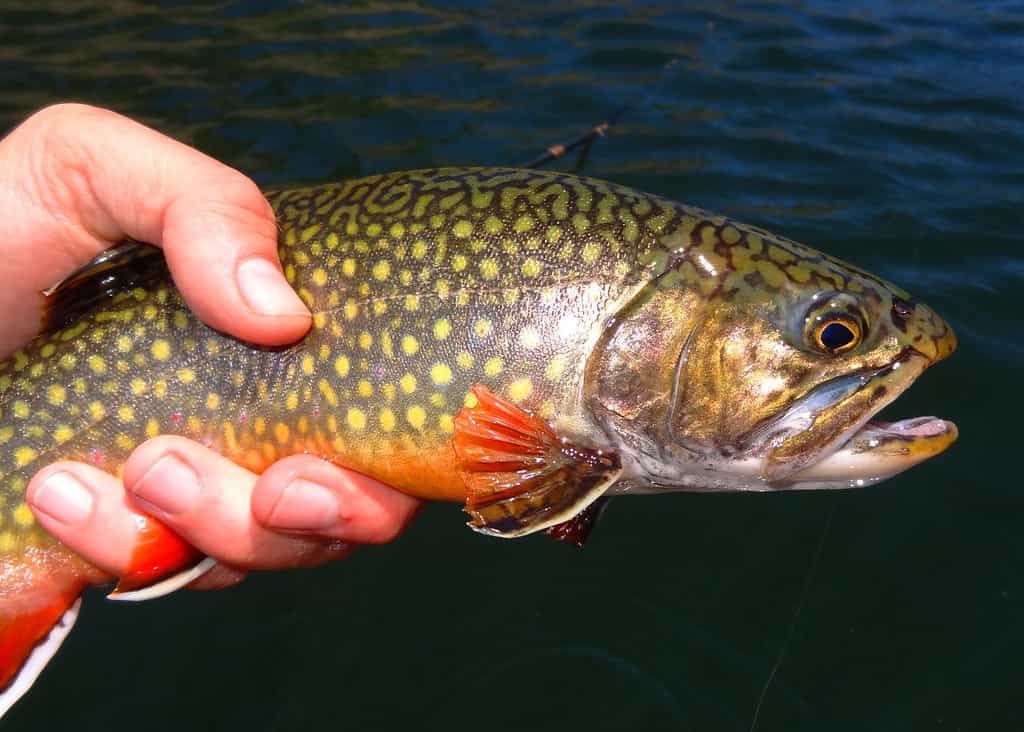
Native to eastern North America, brook trout may be found in high-elevation streams in the United States and Canada. Ranging from east of the Great Lakes all the way to the Atlantic Ocean, brook trout may be found as far south as Georgia. Anglers enjoy fishing for brook trout because brook trout are abundant and aggressive fish. That means that they may be caught with a variety of lures and bait. Also, many note that brook trout have the sweetest taste of all trout and are quick to cook. Although brook trout are typically on the smaller end of game fish, the largest brook trout ever caught in North Carolina was an impressive fish!
Description of Brook Trout

With a dark green back, brook trout have sides that are blue in color with yellow and red spots, which highlight their reddish bellies.
©iStock.com/Coast-to-Coast
Brook trout (Salvelinus fontinalis) are freshwater fish in the char genus of the salmon family. Many times, anglers distinguish a trout from a salmon by where it lives. If the fish lives exclusively in freshwater, it is considered trout. And if it lives in the ocean, returning to freshwater for spawning, it is typically salmon.
With a dark green back, brook trout have sides that are blue in color with yellow and red spots, which highlight their reddish bellies. This fish has a wide middle section that tapers at both ends of its body. Its snout is rounded, and its eyes are amber-gold.
Brook Trout Size
Typically, a brook trout can weigh anywhere between 0.66 to 6.61 pounds. Ones located in the Great Lakes may grow to be over 15 pounds, whereas those living in steams are smaller, typically one to five pounds in weight.
With an average size of 9.8 to 25.6 inches in length, the brook trout in the Great Lakes are on the longer side, usually surpassing two feet in length.
Diet

The Brook trout is so popular it has been named the state fish of nine U.S. states.
©M Rose/Shutterstock.com
As carnivores, brook trout eat a variety of insects, amphibians, and other smaller fish. When they are young, brook trout consume larvae, insects, and plankton. When they reach adulthood, brook trout will eat any prey that will fit in their mouths.
They will feed from dawn until mid-morning and then hunt again at dusk. During the day, brook trout often retreat to deeper water.
Habitat
Brook trout live in rivers, streams, or small ponds with pure water. They cannot tolerate brackish or muddy waters and need high oxygen levels to survive. Sensitive to poor water conditions like pollution, brook trout thrive in waters with a pH of 5.0 to 7.5. Environmental effects, such as acid rain, are particularly hard on brook trout, which are vulnerable to pH changes. Ideally, brook trout look for waters that range from 34°F to 72°F in temperature.
Best Time to Fish for Brook Trout

Brook trout have become a symbol of clean water throughout their native range.
©Matt Jeppson/Shutterstock.com
The best time to catch this fish, like the largest brook trout ever caught in North Carolina, is when they feed. Going out at dawn and dusk gives you the best chance of hooking a brook trout. Look for cool waters; colder than 65°F is ideal for brook trout. Check areas with deep plunge pools around a waterfall or fallen tree. The best spots for brook trout have cover for them to hide from predators but access to the current for hunting insects or other small invertebrates.
In North Carolina, there are a couple of time frames in which fishing for brook trout is ideal. From October to December, there is the Delayed Harvest season, and from March through May is the Hatchery Supported season.
During the Delayed Harvest, streams are stocked with brook trout, but anglers may only use artificial bait, and single hook lures in a catch-and-release style of fishing. This goes until the first Saturday in June when fishing season opens, and you may keep what you catch.
During the Hatchery Supported season, anglers may fish the Hatchery Supported trout waters, which you cannot fish during the Delayed Harvest. Stocked during the spring and early summer, there is no bait or size limit; however, the creel limit is seven trout per day. A creel limit is the total number of fish by species you may harvest in one day. You can check out the updated creel limits for all fish species in North Carolina here.
During the Hatchery Supported season, the waterways are stocked with 960,000 trout. Over 95 percent of the stock is 10 inches or longer in length, with the remaining fish being over two feet long.
The Largest Brook Trout Ever Caught in North Carolina

Fishing on the Raven Fork River, Marshall hooked a brook trout that was seven pounds and seven ounces in size.
©K Steve Cope/Shutterstock.com
G.L. Marshall, Jr. reeled in this record brook trout on May 15, 1980. Fishing on the Raven Fork River, Marshall hooked a brook trout that was seven pounds and seven ounces in size. This was probably a stocked brook trout from a hatchery because wild brook trout don’t usually grow that big outside of the Great Lakes.
The Largest Brook Trout Ever Caught
In Northern Ontario in 1915, a fisherman named Dr. J.W. Cook hooked a brook trout that was 31.5 inches long and 14.5 pounds. Fishing in the Rabbit Rapids of Nipigon River, Cook’s record catch wasn’t weighed right away, and the fish was decomposing by the time it got to a scale. So some surmise that the fish actually weighed around twenty pounds before decomposition began. Cook has held the record for over 100 years.
The photo featured at the top of this post is © Slowmotion GLI/Shutterstock.com
Thank you for reading! Have some feedback for us? Contact the AZ Animals editorial team.







